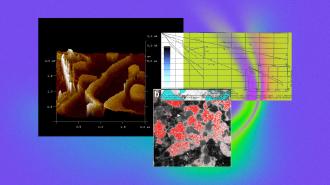Could quantum mechanics — a field that Albert Einstein once derided as “spooky” — affect us in a highly personal way? Quite possibly. Theoretical research is beginning to suggest that quantum effects could drive mutations in human DNA. If true, this could change how we understand cancer, genetic disease, and even the origins of life.
Scientists once thought biological systems too warm, wet, and chaotic to experience weird quantum effects like proton tunneling, in which the particle’s waveform spreads out, allowing it to blip across an energy barrier that would normally block its passage. Generally, the more heat and chaos around, the smaller the quantum effect; so, for many years, scientists thought that in the human body quantum behaviors would be too small to matter.
But you can’t find what you aren’t looking for. As quantum physicists start to poke at the messy and complex world of biology, they are finding quantum mechanics at play, even within our DNA. Welcome to the world of quantum biology.
A primer on point mutations
The iconic double helix of DNA is formed by two coiling molecular strands with bits at the center that connect like puzzle pieces, each with one of four different shapes, named with a letter. T shapes bond to A shapes, and G shapes connect with C shapes, forming what are known as “base-pairs.” These little molecular branches connect through weak attractions between their hydrogen atoms, which have a single proton and electron.
Sometimes, an error occurs and the letters are paired incorrectly — a mistake we call a point mutation. Point mutations can add up and cause problems with DNA, sometimes leading to cancer or other health problems. Most often the result of mistakes during DNA replication, point mutations also can be caused by X-ray exposure, UV radiation, or anything that excites atomic particles to move from their orderly places.
Quantum biology
For 50 years, researchers have debated whether protons switching positions between weakly bound strands of DNA could cause point mutations. The answer seemed like no. Many studies have concluded that the intermediate base-pair states created by proton switching were too unstable and short-lived to be replicated in the DNA. But a new study published in the journal Communications Physics finds that these states can be frequent and stable, and that quantum processes may drive their formation.
The researchers modeled proton transfer between hydrogen bonds of the G:C base-pair in an infinite sea of spring-like vibrating particles, representing the chaotic cellular environment. Their calculations show that proton transfer through quantum tunnelling can happen very quickly for G:C connections at the center of a DNA helix — within a few hundred femtoseconds, or 0.000000000000001 seconds. Such a rate is much faster than our biological timescale.
This switching happens so fast and so often that to our DNA, it “appears” like a proportion of protons are always visiting their neighbors, in the same way that an image on a screen can flash so quickly it looks still to our eyes. This super-fast switching of protons from one side of the bridge to the other means that base-pairs are constantly changing between their original form and a slightly different shape. These intermediate forms can cause a mismatch during DNA replication, when the strands are opened, read, and copied.
Instead of preventing protons from tunnelling, our biological warmth may act as a source of thermal activation, giving protons enough energy to pop over to the other side. Indeed, proton transfer through quantum tunnelling is four times more likely than predicted by classical physics. Not only are these occurrences common, but they are also long-lived. Based on previous computational studies, the researchers predict that these molecular changes should be stable long enough to be replicated — causing a mutation.
There are two primary limitations with the work. First, the researchers did not investigate A:T base-pairs, noting that for these bonds, the intermediate state is highly unstable and not as likely to play a role in DNA mutations. Second, this theoretical work would benefit from experimental tests to validate or challenge the results.
A quantum of solace?
Based on the team’s calculations, point mutations should appear in our DNA much more frequently than they do. The researchers attribute this difference to “highly efficient DNA repair mechanisms” that find and undo the damage. For instance, our DNA replication machinery includes a “proofreading” ability, in which mistakes are detected and corrected — sort of like a typo. Thank goodness for biological copy editors.
The ease of proton tunnelling and the longevity of these intermediate states might even be relevant to studies on the origin of life, the researchers write, because the rate of early evolution is linked to the mutation rate of single-stranded RNA. Thus, though the quantum world might seem weird and distant, it might have played a role in giving us life — and also taking it away.
This article was reprinted with permission of Big Think, where it was originally published.
